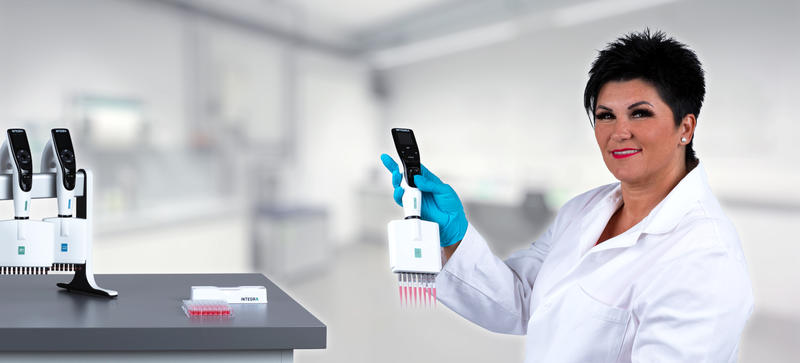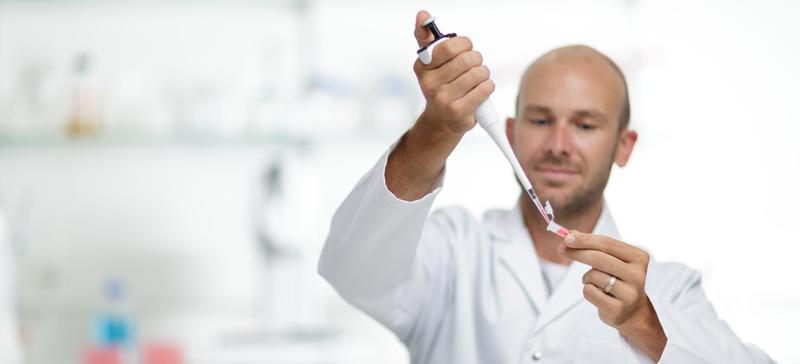-
Implementing the Twist Human Core Exome Kit on MIRO CANVAS®
Automated NGS library preparation and hybridization capture
Whole exome sequencing (WES) provides a unique opportunity to dive deeply into the coding regions of the genome. It plays an important role in generating data for research and, in some cases, clinical applications.¹ Strong WES analyses rely on even coverage of these regions and, ultimately on high quality capture reactions.² Variability in coverage can be minimized by ensuring that reagents are high quality, and by automating laboratory processes that have traditionally been performed manually.³
The Twist Human Core Exome kit undergoes thorough quality control (QC) testing to ensure that all probes in the probe pools are present at the appropriate levels in order to limit wasted reads.⁴ The uniformity of these reagents reduces costs and improves coverage of reads in singleplex and 8-plex pools.⁴ Automating this kit on the MIRO CANVAS reduces the potential for contamination and variability. MIRO CANVAS also provides full walk-away automation, giving users the flexibility to perform other tasks while maintaining high quality results.
MIRO CANVAS NGS prep system is a digital microfluidics platform that allows custom low-throughput workflow automation for complex protocols, such as next generation sequencing (NGS) library preparation and hybridization capture. The system is compatible with a wide range of reagents.⁵ This application note describes the results that can be expected when using the Twist Human Core Exome kit in protocols developed for MIRO CANVAS. The resulting research use only libraries can then be sequenced using Illumina sequencing platforms.
-
Table of contents
Whole exome sequencing (WES) provides a unique opportunity to dive deeply into the coding regions of the genome. It plays an important role in generating data for research and, in some cases, clinical applications.¹ Strong WES analyses rely on even coverage of these regions and, ultimately on high quality capture reactions.² Variability in coverage can be minimized by ensuring that reagents are high quality, and by automating laboratory processes that have traditionally been performed manually.³
The Twist Human Core Exome kit undergoes thorough quality control (QC) testing to ensure that all probes in the probe pools are present at the appropriate levels in order to limit wasted reads.⁴ The uniformity of these reagents reduces costs and improves coverage of reads in singleplex and 8-plex pools.⁴ Automating this kit on the MIRO CANVAS reduces the potential for contamination and variability. MIRO CANVAS also provides full walk-away automation, giving users the flexibility to perform other tasks while maintaining high quality results.
MIRO CANVAS NGS prep system is a digital microfluidics platform that allows custom low-throughput workflow automation for complex protocols, such as next generation sequencing (NGS) library preparation and hybridization capture. The system is compatible with a wide range of reagents.⁵ This application note describes the results that can be expected when using the Twist Human Core Exome kit in protocols developed for MIRO CANVAS. The resulting research use only libraries can then be sequenced using Illumina sequencing platforms.
Key benefits
- Library preparation and hybridization capture using Twist Human Core Exome kit are automated on MIRO CANVAS.
- These protocols have been developed using 50 ng DNA input for library prep and 1500 ng for hybridization capture.
- Depth of coverage, quality scores and other key metrics are comparable between manually prepared libraries and those run on MIRO CANVAS.
- Automating library preparation and hybridization capture on MIRO CANVAS reduces hands-on time by over 85 %.
Overview: How to implement the Twist Human Core Exome kit on MIRO CANVAS
Experimental set-up
The fully automated Twist Universal Library Prep protocol has been tested using 50 ng of high molecular weight DNA. Before beginning, DNA should be quantified using the Qubit™ dsDNA Broad Range Quantification Assay or similar.⁶ Fragmentation, end repair, adapter ligation, amplification and purification steps are all automated in this protocol. The Twist Fast Hybridization Target Enrichment protocol has been tested using single samples and 8-plex pools, and the volume of each sample library used depends on their respective concentrations.⁷ Minimal hands-on sample preparation is required at the beginning of this protocol, leaving most steps automated on MIRO CANVAS, including hybridizing probes with pools, binding targets to beads, post-capture amplification and purification.
Downloads: App note for implementing the Twist Human Core Exome Kit on MIRO CANVAS®
Results
Library preparation
The MIRO Universal Library Prep (Twist) protocol has been tested using 50 ng of NA12878* gDNA. To assess the quality of the library preparation protocol alone on the MIRO CANVAS, hybridization capture was then performed manually. 4 replicates each of the libraries prepared on MIRO CANVAS and manually, 8 in total, were sequenced on an Illumina NextSeq High Output 75PE platform. Key metrics, such as depth of coverage and Fold-80 scores, were comparable between the methods. Additionally, both methods yielded a similar percentage of duplicated reads and reads on target (Figure 2).
*NA12878 DNA was obtained from the NIGMS Human Genetic Cell Repository at the Coriell Institute for Medical Research.
Target enrichment
The Twist Fast Hybridization Target Enrichment protocol has been tested using inputs of both 1500 ng of mixed DNA for 8-plex pools (multiplex, 187.5 ng per library), and 500 ng for individual libraries (singleplex). Samples run on MIRO CANVAS for hybridization capture previously underwent manual library preparation. Sequencing was performed using the NextSeq High Output 75PE platform. Samples that were run on MIRO CANVAS, both singleplex and 8-plex pools, were compared to singleplex samples that had been enriched manually. Coverage of target bases at 20x and 30x was comparable between manual and automated protocols for single samples and 8-plex pools. Fold-80 scores were also similar between methods, with median scores varying no more than 0.02 (Figure 3).
Additional sequencing was completed using two 8-plex pools, one prepared manually and the other on MIRO CANVAS. Targets covered at 30x and Fold-80 scores for each pool were comparable (Table 1). Reads for these runs were assessed using the MIRO CANVAS Integrative Genomics Viewer (IGV). The IGV outputs displayed confident mapping of target genes across multiple exons from pools enriched using MIRO CANVAS (Figure 4).
Table 1: Key metrics were comparable for 8-plex pools enriched manually and on MIRO CANVAS. All samples were subsampled to 150x raw sequencing coverage (70M reads, 5.3 Gb of data per sample).
Time savings
While the overall time taken between the library preparation and hybridization capture protocols does not vary significantly between manual preparation and MIRO CANVAS automation, the hands-on time is far less for the automated applications. Manual library preparation requires about 3 hours of hands-on time, while the Twist Universal Library Prep requires about 15 minutes to set up for a 3 hour 20 minute fully automated run.
The Twist Fast Hybridization Target Enrichment protocol begins with several steps that cannot be automated, such as preparing pools and hybridization mix, and therefore requires about an hour of benchtop work. The steps that follow are fully automated on MIRO CANVAS, taking about 5.5 hours to complete. This hour of hands-on time pales in comparison to the time taken by the manual protocol, which requires as much as 7.5 hours of hands-on time.
References
- Rabbani B et al. The promise of whole-exome sequencing in medical genetics. J Hum Genet 2014; 59: 5–15. https://doi.org/10.1038/ jhg.2013.114
- Lelieveld SH et al. Comparison of exome and genome sequencing technologies for the complete capture of protein-coding regions. Hum Mutat 2015; 36: 815-822. https://doi.org/10.1002/humu.22813
- Holland I and Davies JA. Automation in the life science research laboratory. Front Bioeng Biotechnol 2020; 8: 571777. https://doi.org/10.3389/fbioe.2020.571777
- Twist Bioscience. Human core exome kit. Available at: https://www.labline.it/wp-content/uploads/2020/01/ProductSheet_NGS_ ExomeKit_26Jun_19_Rev2.1.pdf. Accessed Feb 2022.
- Miroculus. New Class of Technology. Available at: https://miroculus.com/technology/. Accessed February 2022.
- Miroculus, Inc. Miro Universal Library Prep (Twist) Protocol. Available at: https://miroculus.com/. Accessed: Feb 2022.
- Miroculus, Inc. Miro Human Exome Hyb Capture (Twist) Protocol. Available at: https://miroculus.com/. Accessed: Feb 2022.
Conclusion
- MIRO CANVAS is an advanced digital microfluidics platform that can be used to automate library preparation and hybridization capture with the Twist Bioscience Human Core Exome kit. Both the Twist Universal Library Prep and Twist Fast Hybridization Target Enrichment protocols are fully automated from fragmentation to elution and hybridization to elution, respectively.
- These automated protocols and their manual counterparts yield comparable results. However, the greatly reduced hands-on time required by MIRO CANVAS makes it a valuable tool for any laboratory.
Related articles
Further reading:
Ask our expert. Leave a comment!
Write us if you have any questions regarding the application note or one of our instruments.
Any questions? I'm happy to help!
Instruments and accessories
MIRO CANVAS, NGS prep system
A revolutionary microfluidics platform which enables full automation of NGS prep protocols.
-
Fully automated - Simple, walk-away automation for on-demand NGS sample preparation
-
Efficient - Minimize costs with up to 75 % reduction in reagent use and only 15 minutes of hands-on time
-
Flexible - Established NGS sample prep protocols for both short- and long-read sequencing platforms
Part No. M-01-0001-001-01
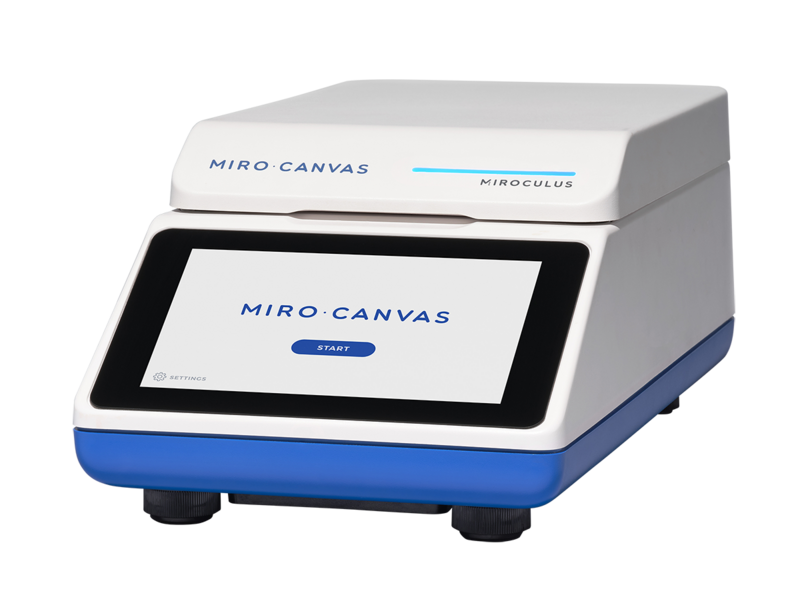
MIRO Cartridge
The MIRO Cartridge is a single use consumable suitable for running library prep workflows on the MIRO CANVAS instrument (for Research Use Only)
Part No. M-02-0001-001-03
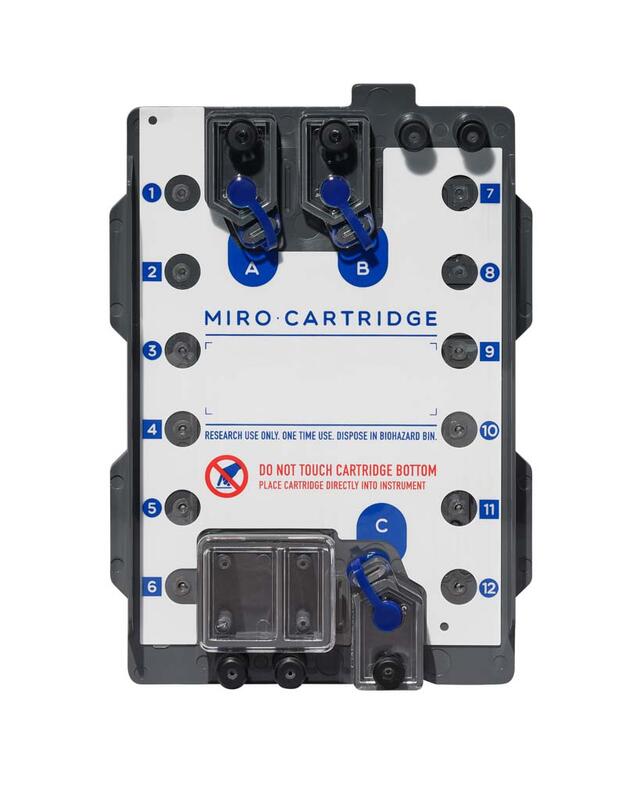
MIRO Dropgloss
MIRO Dropgloss is a proprietary system reagent that helps mitigate evaporation. (for Research Use Only)
Part No. M-03-0001-001-01
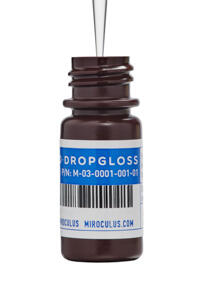
Twist Biosciences: Twist Human Core Exome, 12 Reactions, Kit
The NGS Human Core Exome provides the ability to lower sequencing costs, increase sample throughput, and achieve a higher depth of coverage across target regions with uncompromising quality.
Part No. 102026
Coriell Institute for Medical Research: Genomic DNA from LCL
Ceph/utah Pedigree 1463 International Hapmap Project - Ceph (Plate I) [utah Residents With Ancestry From Northern And Western Europe] Cytochrome P450, Subfamily Iic, Polypeptide 19; Cyp2c19 International Hapmap Project - Ceph [utah Residents With Ancestry From Northern And Western Europe] Na Custom Service Plate 01
Part No. NA12878
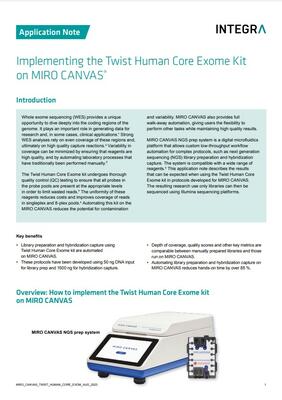
Downloads
Download App Note as PDF
DownloadImplementing the Twist Human Core Exome Kit on MIRO CANVAS®
